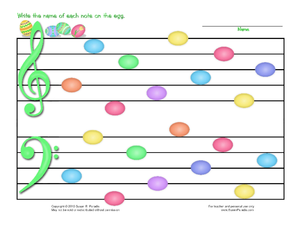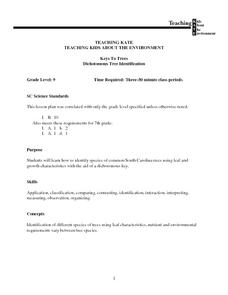Curated OER
Notes in the Fast Lane: Quiz
Here are four quizzes that cover note identification on the staff. Each page contains four sections, where the timed learners must identify and fill in the name of each note. These are titled as level 5, 6, 7, and 8, which implies that...
Curated OER
Timed Note Identification
Before you can play from sheet music, you need to be able to read it. This timed quiz requires the class to identify as many of the 90 notes as they can. Notes are on a staff in both treble and bass clef.
Curated OER
Note Identification – Grade 2
In this musical note identification worksheet, students examine 10 musical notes and then respond to 6 questions that require them to identify notes and notes in common time.
Curated OER
Note Identification Grades 3-5
In this musical note identification worksheet, students examine 10 musical notes and then respond to 8 questions that require them to identify notes and notes in common time.
Curated OER
Note Identification Kindergarten
In this musical note identification worksheet, students examine 8 musical notes and then respond to 4 questions that require them to match notes and notes in common time.
Curated OER
Note Identification – Grade 1
In this musical note identification worksheet, students examine 8 musical notes and then respond to 4 questions that require them to identify notes and notes in common time.
Curated OER
Easter Egg Musical Notes
Pastel Easter Eggs are all over this staff, and it's up to your young musicians to analyze each one. They write the name of the note in each egg to practice identifying notes while reading music.
Curated OER
Music Review Test
Wow this is a really thorough music quiz. There are a total of seven tasks for the class to complete. They must, write the C major scale, identify notes on the staff, write four major keys based on the information provided, identify...
Virginia Department of Education
Mineral Identification
What's the difference between a rock and a mineral? And what properties are used to identify minerals? The first installment of a five-part series on earth materials and processes prompts young scientists to identify a set of...
Curated OER
Fearless Flats
This handout gives budding musicians an opportunity to practice placing and identifying notes and flats. A mnemonic is used to help them remember the names of each note as it appears on the staff.
Curated OER
Missing the Major Scales 2
Any musician can tell you, you have to know your scales, key signatures, and notes when reading sheet music. Kids are quizzed on major scales and the notes found with in each scale. They fill in the missing notes and identify each scale.
Curated OER
Note Names & Piano Games
Students identify the letter names of notes, demonstrate simple rhythms, and combine the two to play short melodic phrases using Bug Band. They create their own melodies and play them using Bug Band and various instruments.
Curated OER
Music Box Identification
Fourth graders draw and label music notes and rests. In this music box lesson students use staff paper to draw the notes required. The students give the value of each note or rest.
Science Education Resource Center
Compare and Contrast deciduous and evergreen tree leaves to aid in tree identification
Boost observational skills and get to know the difference between deciduous, coniferous, and evergreen trees with a lesson that challenges scholars to compare, contrast, identify, sort, and draw their findings.
AAAS
Identification and Classification of Grassland Plants
Take learning outside and start classifying grasslands. Young ecologists observe grassland plants in order to classify them into the appropriate species by family. They note their characteristics and where they grow. A true field...
K-State Research and Extensions
Crystal Shapes
Of quartz I love geology! The chapter offers five activities at three different levels. It features hands-on activities that cover crystal shapes, cleavage and fracture, hardness scale, specific gravity, and mineral identification....
Curated OER
Simple Sharps
If you want to play music, you need to learn how to read sharps and flats. Young musicians practice reading and playing these simple sharps. Each sharp is given a word that connects it to the note it is related to. For example: Charles...
Curated OER
Phoneme Identification with Sound-it-Out Chips
Looking for a tangible way to help emerging readers identify phonemes? You've found it! They use chips without letters to segment single-syllable words into first, middle, and last sounds. As you say each sound, scholars place a chip on...
Curated OER
Using Harmonic Vision’s Music Ace Software to Reinforce Basic Music Skills
If you have access to Harmonic Vision’s Music Ace Software, then this instructional activity could work for you. Kindergarteners use the video music software to place, identify, and read musical notes. They listen in and identify both...
Curated OER
Teaching the Instruments of the Orchestra to Young Students using the San Francisco Symphony Kids’ Website
Using the San Francisco Children's Orchestra web site, first graders build listening and instrument identification skills. Each child wears head phones, listens to ID, and finds various instruments on the included worksheet.
Michigan State University
Bug Lyphe!
Introduce ecology classes to biodiversity and interdependence in ecosystems with a PowerPoint presentation. Then, they get up-close and personal with the invertebrate world by collecting insects, classifying them, and graphing their...
Curated OER
Keys To Trees: Dichotomous Tree Identification
Ninth graders gather samples of different tree leaves in their neighborhoods, and on school grounds, and identify several species of common South Carolina trees using leaf and growth characteristics with aid of dichotomous key.
CK-12 Foundation
Identification of Angles by Vertex and Ray
Angle ABC is not the same as angle BCA, but it is the same as angle CBA. Help your classes understand naming conventions of angles and, more importantly, the importance of naming angles correctly. Scholars practice the parts of the angle...
Curated OER
Cherokee Leaf Printing
Young scholars investigate their local creeks and forests and practice identifying trees. For this ecology identification lesson, young scholars utilize a pad and pencil while on a field trip near their school and describe their trip...

























